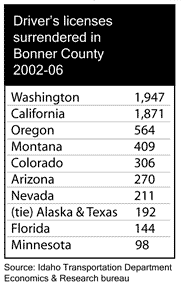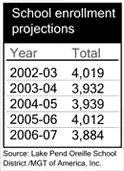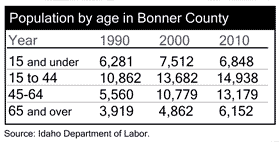The changing face of Sandpoint
Demographics paint
the present and
predict the future
By Keith Kinnaird |
|
Photo by Doug Marshall / El Photo Grande |
A quick glance of Idaho Transportation Department (ITD) driver’s license statistics shows people from all over the country are moving to Bonner County. A closer look at the figures suggests Delaware is the only state in the union with a resident who didn’t surrender a license here between 2002 and 2006.
 |
The license statistics are skewed by the nomadic tendency of those who move in and just as quickly move out and the power of procrastination among those who wait until the last second – or longer – to obtain an Idaho license.
“These are just indicative,” qualifies Doug Benzon, an economist who manages the Economics & Research bureau at ITD. “It isn’t numerically perfect, but it is what has been surrendered.”
The numbers tend to indicate most of the demographic infill is coming from Washington, followed by California. Former residents of Oregon, Montana, Colorado, Arizona and Nevada trail as newly (or nearly) bona fide Bonner County residents, but by a vast margin. Alaska and Texas tie for the next spots, while Florida and Minnesota round out the top 10 émigré-producing states during the five-year period tabulated by state transportation officials.
Bonner County has unquestionably attained its mark on the map of the “Third Coast,” a colloquialism used to describe picturesque places beyond the East, West or Gulf coasts. Inland terrestrial expanses are the new ocean vistas in the eyes of many, according to land-use planners and professionals.
“They’re now attracted by the wide open spaces like we have, where so much of our land is federal or state land. That’s become the new attraction instead of the Atlantic or Pacific. It’s now the interior where the wide open spaces become the attractant,” said Clare Marley, Bonner County’s planning director.
Bonner County’s abundance of sun-dappled waterways, boilerplate prairies and rugged mountains means people will be drawn here. But the exodus of urban and suburban refugees is coming with more baggage than a bellhop.
 |
Housing costs are reaching breathtaking heights, and a different breed of development is taking hold. The older population is expanding, and its youthful counterpart is contracting.
One of the most visible indicators of Bonner County’s burgeoning popularity can be found in the real estate listings. The average price of a home here has vaulted more than 35 percent in the past two years and doubled in the last five, according to the Selkirk Association of Realtors’ Multiple Listing Service. The average selling price of a home here ranged from $328,000 to $346,000 in 2007.
There is evidence to suggest a change in the real estate climate, though.
“There’s been quite a market adjustment. We’ve been looking at the sales of homes against our own building permits and tracking the numbers. We could lay a graph of the number of homes sales over the number of building permits and it’s almost identical. I think that there’s been a cooling, partly with what’s going on in the mortgage markets,” said Marley.
The market adjustments might make it a good time to buy, but that doesn’t mean a lot of people can.
An affordable housing needs study commissioned by the city of Sandpoint found that almost half of the full-time residents earn less than $35,000 a year, a sum considered low-income by industry standards. People in that income bracket, the study concluded, could pay no more than $103,000 for a home without being cost-burdened – a far cry from the average asking price for real estate (see Marketwatch, page 132).
Census figures crunched by the Idaho Department of Labor (IDL) show Bonner County’s population mosaic, much like that of the state and nation, is in flux. The number of people 44 years old and younger is growing, but their percentage within the overall population is shrinking.
The trend is especially pronounced in the 15-and-under set in Bonner County. The age group represented 23 percent of the population in 1990, but slipped to 20 percent in 2000 and to 16 percent in 2005, IDL figures indicate.
 |
School enrollment projections for the Greater Sandpoint area appear to backstop the state’s analysis. The enrollment history hints at the makings of a period of small but steady declines.
Total enrollment projections for the Lake Pend Oreille School District hovered above the 4,000 mark for 2001 and 2002, but began to slip slightly in subsequent years. It regained the lost ground by 2006, but dipped again the following year, the projections indicate.
The 6-percent decline in enrollment last year had school district officials planning for the worst and hoping for the best because attendance figures have such a dramatic influence on public funding and, therefore, budgets.
“Because we had such a big drop last year, we used the most conservative projection they gave,” said district Superintendent Dick Cvitanich, referring to the firm which conducted the enrollment projection analysis. “We had our conservative projection, and we sort of had this hopeful outlook.”
The district used the low-ball projection of 3,763 students and counted 3,774 students on the first day of classes in September. But by opening week’s end, enrollment climbed to 3,815 students.
“The bottom line is we started off OK, but we’re still down in total enrollment from where we would like it to be,” Cvitanich said.
It’s the second consecutive year total enrollment has slumped in the district, but Cvitanich is not ready to jump to conclusions.
“You wonder at what level it will level off, but we just don’t know where that is yet. What I do know from the time that I’ve been here is that we’ve seen two decreases,” he said. “If someone asked me, ‘Do you think this is a trend?’ I would say, ‘Two years does not make a trend, but it has me looking very closely at it.’ ”
Although the census shifts in Bonner County more or less track with the shifts occurring statewide and nationally, the high cost of housing is a prime suspect in deterring families with school-age kids from moving here.
“With the real estate prices rising so rapidly, it has scared away a few young families and prevented other young families from moving in,” said Kathryn Tacke, IDL’s Panhandle region economist.
Cvitanich has a similar belief. “I just know that when you see a drop of approximately 100 students there’s, in my mind, something going on affecting the livability for families,” he said.
The older set in Bonner County, meanwhile, is growing in both number and proportion within the total population, according to IDL figures. The 45- to 64-year old age bracket accounted for 20 percent of the overall population in 1990. By 2005, it represented more than 32 percent.
The type of housing being developed here appears to be changing with the demographic. Exclusive and leisure-oriented developments are on the rise.
“Before we had what I consider fairly simple subdivisions. Now we have gates and golf courses. They’re popping up all over, and they’re a different flavor than what we used to ever see,” said county planning director Marley.
 |
Community leaders are also seeing an increase in the number of new people who aren’t dependent on a job here or anywhere else for that matter. Some hold down jobs where geographic location is irrelevant; still more are retired.
“The difference is the people that are moving here are the ones that can afford to live here. They don’t derive their income from here; they don’t have a job here,” said Karl Dye, executive director of the Bonner County Economic Development Corporation (BCEDC).
What’s to be done?
A coalition of public and private interests formed the Bonner Community Housing Agency to mute the gentrification occurring here. The nonprofit housing education and advocacy group is studying ways to develop more affordable housing, such as through land trusts and liberalized density limits in certain areas.
Stephen Drinkard, project coordinator for the City of Sandpoint, has taken an active role in the affordable housing issue. Drinkard sees the development of workforce housing as the best hope in filling the gap.
“It’s a really crucial thing. If we can continue to find ways to get people to be able to live in and near their workplace in the Greater Sandpoint area, there will be a counterbalance to the values brought in by the wealthier people,” Drinkard said.
For its part, the BCEDC has made it its mission to restore the affordability of living here.
“As long as you keep your economy strong by constantly working on trying to increase the average wage, trying to create more and better jobs, you can hopefully balance that out,” said Dye. “If you balance out the prevailing job wage along with the increased cost of living, then hopefully you can maintain your community.”
Sandpoint’s transition from a resource-based economy is often viewed dismissively as a step down to a service economy dominated by low-paying jobs. However, there is a growing body of evidence that tends to deflate the myth that we are a resort community with a plethora of service industry jobs and not much else.
A number of companies, including Coldwater Creek, Litehouse Foods, Panhandle State Bank, Unicep Packaging, Quest Aircraft and Encoder, have brought significant diversity to the labor market.
Dye feels those companies’ leaders believing in the community is a large part of what is keeping them here.
“All of those people made a commitment to this community. It might not have made the best business sense, and it might not have been the best return on their investment to stay here, but they believed in this community,” he said.
Tacke contends Sandpoint’s tag as a resort community misses the mark.
“In a way I don’t even like using ‘resort community’ for Sandpoint, because I think it really understates,” she said. “For the size that it is, it’s amazing the variety of operations you have. What really stands out in my mind is the number of corporate headquarters you have there. The growth of those operations certainly has created a large variety of professional and managerial jobs that wouldn’t have existed in the community 10 years ago.”
|